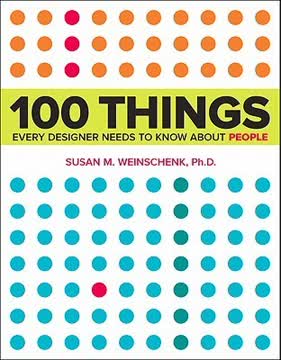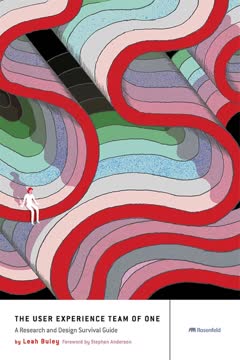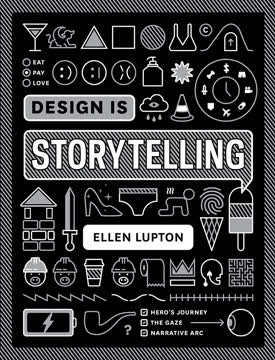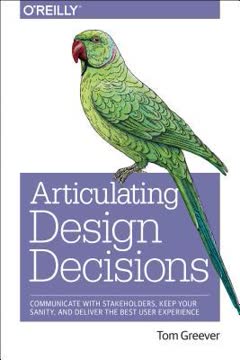Key Takeaways
1. Design is more than aesthetics; it solves business problems
"Our challenge is that each view is supposed to be sorted chronologically so that users know to expect the most recent content at the top. This keeps the list of posts fresh and ensures that all the content creators are submitting new content each week."
Design solves problems. In today's business landscape, design has evolved from merely making things look attractive to addressing critical business challenges. Designers must focus on creating solutions that not only look good but also drive measurable results.
- Key aspects of problem-solving design:
- Aligns with business goals and metrics
- Improves user experience and engagement
- Increases conversions and revenue
- Enhances brand perception and loyalty
By approaching design from this perspective, designers become valuable assets in driving business success and innovation.
2. Effective communication is crucial for designers
"Being articulate can make you successful in any area of life. It can help you get almost anything you want: a job, a spouse, or a bargain."
Communication is a designer's superpower. The ability to articulate design decisions clearly and persuasively is often more important than raw design skills. Effective communication helps designers:
- Gain stakeholder buy-in for their ideas
- Defend design choices with confidence
- Collaborate more effectively with team members
- Advance their careers and earn respect
To improve communication skills, designers should focus on:
- Tailoring their message to different audiences
- Using clear, jargon-free language
- Backing up design decisions with data and reasoning
- Practicing active listening and empathy
3. Understand and empathize with stakeholders
"There are always other things going on in the room that you will never know about. There are always things that are influencing people's behaviors that we are not privy to. And there will always be things that we simply can't predict. Always."
Empathy drives better design. Understanding stakeholders' perspectives, motivations, and challenges is crucial for effective collaboration. Designers should:
- Recognize that stakeholders are human, with their own pressures and priorities
- Create shared experiences to build rapport and trust
- Ask thoughtful questions to uncover underlying needs and concerns
- Identify key influencers and decision-makers within the organization
By developing empathy for stakeholders, designers can anticipate objections, tailor their approach, and create solutions that address both user needs and business objectives.
4. Prepare thoroughly before design meetings
"Before anything else, preparation is the key to success."
Preparation prevents poor performance. Thorough preparation before design meetings sets the stage for productive discussions and positive outcomes. Key preparation steps include:
- Anticipating stakeholder reactions and questions
- Creating alternative design options to address potential concerns
- Gathering relevant data and research to support design decisions
- Preparing visual aids and examples to illustrate key points
Additionally, designers should:
- Review the meeting agenda and objectives
- Practice their presentation and responses to potential feedback
- Identify allies who can support their ideas during the meeting
- Set up the meeting environment to minimize distractions
5. Master the art of listening to stakeholder feedback
"Listening isn't just waiting for the other person to stop speaking so that we can begin our response. The entire purpose of careful listening is to ensure that we understand our stakeholders before responding."
Active listening unlocks insights. Effective designers master the art of truly hearing and understanding stakeholder feedback. This involves:
- Allowing stakeholders to express their thoughts fully without interruption
- Paying attention to non-verbal cues and underlying emotions
- Taking detailed notes to capture important points and action items
- Asking clarifying questions to ensure complete understanding
Techniques for improving listening skills:
- Paraphrasing stakeholder comments to confirm understanding
- Acknowledging concerns and validating stakeholder perspectives
- Identifying the real problem behind surface-level feedback
- Using the "pause" technique to allow for reflection before responding
6. Develop the right mindset for responding to feedback
"First learn the meaning of what you say, and then speak."
Mindset matters in communication. Approaching feedback conversations with the right attitude is crucial for productive outcomes. Key mindset shifts include:
- Giving up control and embracing collaboration
- Checking ego at the door and remaining open to new ideas
- Leading with a "yes" to create an atmosphere of agreement
- Being charming and approachable to build rapport
Designers should also:
- Change their vocabulary to focus on effectiveness rather than personal preferences
- Use transitional phrases to set the stage for their response
- Remember that the goal is to find the best solution, not to be right
7. Craft compelling responses using the IDEAL framework
"Identify the problem, Describe your solution, Empathize with the user, Appeal to the business, Lock in agreement."
IDEAL responses drive agreement. The IDEAL framework provides a structured approach to responding to stakeholder feedback:
- Identify the problem: Clearly state the issue being addressed
- Describe your solution: Explain how your design solves the problem
- Empathize with the user: Connect the solution to user needs and behaviors
- Appeal to the business: Link the design to business goals and metrics
- Lock in agreement: Directly ask for stakeholder buy-in
Using this framework helps designers:
- Organize their thoughts coherently
- Address stakeholder concerns systematically
- Demonstrate the value of their design decisions
- Move the conversation towards a positive resolution
8. Follow up effectively after design meetings
"The meeting after the meeting may be more important than the meeting itself."
Post-meeting actions cement decisions. Effective follow-up after design meetings is crucial for maintaining momentum and ensuring alignment. Key follow-up steps include:
- Sending a summary email promptly after the meeting
- Documenting decisions and action items clearly
- Seeking out individual stakeholders for additional feedback or clarification
- Making quick decisions on ambiguous issues to keep the project moving forward
Best practices for follow-up:
- Use clear, concise language in summary communications
- Assign specific responsibilities and deadlines for action items
- Provide visual aids or mockups to reinforce key points
- Schedule follow-up meetings or check-ins as needed
9. Recover gracefully from design setbacks
"In every difficult situation is potential value. Believe this; then begin looking for it."
Setbacks are opportunities for growth. Even the best designers face challenges and disagreements. Recovering gracefully from setbacks involves:
- Maintaining a positive attitude and looking for opportunities in challenges
- Being willing to make changes while preserving the core user experience
- Choosing battles wisely and building trust with stakeholders
- Admitting mistakes honestly and focusing on solutions
Strategies for turning setbacks into successes:
- Use the "bank account of trust" concept to build goodwill over time
- Find creative ways to implement stakeholder requests without compromising design integrity
- Use setbacks as opportunities to uncover deeper problems or innovative solutions
- Learn from mistakes and use them to improve future designs and processes
10. Empower non-designers to work effectively with designers
"Recognize that we are good at our jobs."
Collaboration empowers great design. Non-designers play a crucial role in the success of design projects. To work effectively with designers, they should:
- Trust designers' expertise and decision-making
- Prioritize designers' needs to enable efficient work
- Empower the team to move quickly and make decisions
- Recognize that designers are people with diverse skills and perspectives
Best practices for non-designers:
- Focus on describing problems rather than prescribing solutions
- Ask questions to understand design decisions
- Provide clear, actionable feedback
- Be prepared for design meetings and review materials in advance
11. Design for vision to shape the future of organizations
"We have what it takes to create the images that make the unreal real. Most people can't do that."
Visionary design drives innovation. Designers have the unique ability to visualize and communicate future possibilities. By designing for vision, they can:
- Inspire stakeholders with compelling future scenarios
- Drive organizational change and innovation
- Build credibility as strategic thinkers
- Create excitement and buy-in for long-term projects
Techniques for designing for vision:
- Practice creativity regularly through sketching and ideation
- Seek inspiration from diverse sources and industries
- Create visual artifacts that bring future concepts to life
- Present vision designs alongside current project work to build excitement
By embracing their power to shape the future, designers can elevate their role within organizations and drive meaningful change through their work.
Last updated:
FAQ
What's Articulating Design Decisions about?
- Focus on Communication: The book emphasizes the importance of effectively communicating design decisions to stakeholders. It provides a framework for articulating design choices in a way that resonates with non-designers.
- Stakeholder Engagement: It discusses strategies for engaging with stakeholders, understanding their perspectives, and building relationships that foster collaboration.
- Practical Techniques: Offers practical techniques and frameworks for preparing for meetings, listening to feedback, and responding to critiques.
Why should I read Articulating Design Decisions?
- Improve Communication Skills: If you struggle to communicate your design ideas effectively, this book offers valuable insights and methods to enhance your communication skills.
- Real-World Examples: The author shares personal anecdotes and real-world examples that illustrate the challenges and successes of articulating design decisions.
- Build Better Relationships: Reading this book can help you build stronger relationships with stakeholders, leading to more successful design outcomes.
What are the key takeaways of Articulating Design Decisions?
- Communication is Key: Effective communication is crucial for designers to gain approval and support for their work.
- Understand Stakeholder Perspectives: Understanding the perspectives and values of stakeholders can help tailor your communication and design decisions.
- Preparation and Practice: Thorough preparation and practice before meetings are essential, including anticipating objections and rehearsing responses.
What are the best quotes from Articulating Design Decisions and what do they mean?
- “If we don’t get approval for our designs, our projects won’t see the light of day.”: Highlights the critical role of stakeholder approval in the success of design projects.
- “The way we talk about design to our stakeholders is critical to the success of our projects.”: Emphasizes that communication is a fundamental part of the design process.
- “Good communicators win.”: Captures the essence of the book, indicating that strong communication skills can set designers apart in their careers.
What specific methods does Tom Greever suggest for improving communication?
- Thank, Repeat, Prepare: A simple transition method for responding to feedback by thanking stakeholders, repeating their points, and preparing them for your response.
- Active Listening Techniques: Includes taking notes, asking clarifying questions, and rephrasing what stakeholders say to ensure understanding.
- Anticipate Reactions: Advises anticipating stakeholder reactions based on their roles and values to craft more effective arguments.
How can I reduce cognitive load during design meetings according to Articulating Design Decisions?
- Remove Distractions: Eliminate distractions that could divert attention from the main agenda, such as irrelevant visuals or placeholder content.
- Prepare Thoroughly: Being well-prepared with an agenda and anticipated objections can help streamline the meeting.
- Practice Responses: Practicing your presentation out loud can help you articulate your points more clearly.
What role does listening play in articulating design decisions?
- Understanding Stakeholder Needs: Listening is crucial for understanding the needs and concerns of stakeholders.
- Building Trust: Effective listening demonstrates respect for stakeholders’ opinions, which helps build trust.
- Facilitating Better Communication: Allows designers to rephrase and clarify feedback, ensuring everyone is on the same page.
How can I build better relationships with stakeholders according to Articulating Design Decisions?
- See Them as Human: Recognize stakeholders as individuals with their own lives and challenges to foster empathy.
- Create Shared Experiences: Engage in informal conversations or team-building activities to establish common ground.
- Be Yourself: Authenticity in your interactions helps build rapport and trust.
What are some common pitfalls to avoid when presenting design decisions?
- Being Defensive: Avoid becoming defensive when receiving feedback; approach discussions with an open mind.
- Overusing Jargon: Use clear and accessible language instead of technical jargon that stakeholders may not understand.
- Ignoring Feedback: Failing to acknowledge or address stakeholder feedback can lead to misunderstandings and resentment.
How can I effectively respond to stakeholder feedback according to Articulating Design Decisions?
- Acknowledge Their Input: Start by thanking stakeholders for their feedback and summarizing their main points.
- Use Data to Support Your Decisions: Back up your design choices with data or research to add credibility to your arguments.
- Be Open to Discussion: Encourage a collaborative atmosphere by inviting further questions and discussions.
What is the IDEAL response framework in Articulating Design Decisions?
- Identify the Problem: Clearly state the problem your design addresses to ensure everyone is on the same page.
- Describe Your Solution: Connect your design solution directly to the identified problem, explaining its effectiveness.
- Empathize with the User: Highlight how your solution benefits the user, reinforcing the importance of user-centered design.
How does Articulating Design Decisions address the importance of empathy in design?
- Understanding User Perspectives: Emphasizes the need to empathize with users by understanding their needs and motivations.
- Building Relationships: Extends empathy to stakeholders, fostering better collaboration and communication.
- User Stories: Incorporating user stories into discussions helps stakeholders visualize the impact of design decisions.
Review Summary
Articulating Design Decisions receives mostly positive reviews, with readers praising its practical advice on communicating design choices to stakeholders. Many find it valuable for improving soft skills and navigating corporate politics. The book is particularly recommended for junior designers and those new to UX. Some readers note that certain sections feel repetitive or obvious to experienced professionals. Overall, reviewers appreciate the real-life examples, clear structure, and focus on building relationships and empathy in design communication.
Similar Books










Download PDF
Download EPUB
.epub digital book format is ideal for reading ebooks on phones, tablets, and e-readers.




